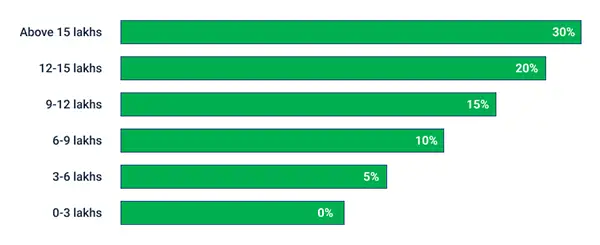Everything You Should Know About Indirect Taxes While Online ITR Filing
Introduction
When filing your income tax return (ITR) online, it’s imperative to have a comprehensive understanding of various aspects, including indirect taxes. These play a significant role in the overall monetary structure and affect financial transactions. After its implementation tax evasion certainly has been reduced and the process of management of levy for services and goods has turned transparent. If you’re an individual or a business entity, being well-informed about this concept is vital for accurate ITR filing.

After the introduction of service levies with both central and state involved, people usually stay aloof from these concepts. In this article, we will delve into everything you should know about these taxes and their relevance to online ITR.
Do You Know: The Central Board of Direct Taxes, a statutory authority for dealing with levy-related matters was formed under the Central Board of Revenue Act, 1963.
What are Indirect Taxes?
There are two types of taxes that a taxpayer needs to pay – direct and indirect. Direct taxes are the ones that are imposed on the taxpayer’s income, profit, or revenue. Indirect one needs to finance any goods and services rendered. Authorities impose them along with the price of goods and services bought by the person.
There are certain rules and procedures required to apply for it. It is requisite to fill them as they are progressive in nature and benefit all; buyer, seller, and the government. After the introduction of it, several tax frauds have been reduced.
Who Needs to Pay Indirect Taxes?
There are various types of indirect taxes, and depending on the nature, a taxpayer may or may not have to go for it. Let’s look at the different categories and the need to finance those levIES, as it will assist during ITR filing.
Custom Duty
It is imposed on goods exported or imported into India. So, when a taxpayer imports a good to India and exports a good out of India, they will need to go for customs duty, a kind of indirect tax. The retailers and consumers in India finance it. Its only purpose is to shield the country’s economy, jobs, entertainment, residents, etc., by controlling the flow of goods across international borders.
Excise Duty
Till 30th June 2017, excise duty played a significant role in the merchandise manufactured in India. The government imposes this on the goods which are manufactured within India. There are still commodities such as high-speed diesel, tobacco products, aviation turbine fuel, and petroleum crude on which the taxpayers must pay this amount.
GST
GST, or goods and services tax, replaced what used to be an excise duty. It is applied to every individual or business owner in the supply of commodities and services. It is to be paid by people with an income turnover of more than the prescribed limit.
After its implementation people have rather found the price of things to be dropped as the “tax on tax” concept got eliminated and relieved everyone. There are various online GST portals available that help in GSat returns, applications, refunds, and much more.
These were some of the concepts related to levy related concepts. Also, one can learn these concepts briefly at various websites like www.irs.gov , they assist learners with lessons, assessments, worksheets, and activities.
Interesting Fact: GST got implemented on July 01, 2017, where various taxes were paid simultaneously under a single tax. The amount charged on the goods is prescribed by the GST council, while some of the articles are exempted from it.
Everything About Filing GST
Goods & services tax is the indirect tax that holds a major significance at the time of income tax return filing. Therefore, understanding how it functions is also imperative. The government imposes GST at every step of supply. Besides, there can be the state and central service levy in the intra-state sale of the product. However, an integrated GST is applied to the product if the supply is only inter-state.
With the help of technology, paying taxes is becoming simpler, and this goes for levy cases as well. There is an online GST portal where taxpayers can register, file their GST returns and apply for any refund, if applicable.
The service tax council has prescribed different tax rates, starting from 0% to 28%, and different commodities wares, and services used. In addition, there are certain merchandise that are exempted from GST.
Example of GST Application
Most indirect taxes are now being taken over by GST, or goods and services tax. It applies to even the most minor things, such as eating out in a restaurant. With the help of the below example, let’s understand how it is applied and how much the taxpayer needs for that.
For instance, if you decide to go out and eat in a restaurant, your GST will be applied to the total bill. You can see the total amount plus the service tax amount on the bill. The tax rate for eating in restaurants is 5%. Now, if your total bill was Rs. 2500 for food, you will be charged an additional amount of Rs. 125 (5% of 2500) as GST, and your total will be Rs. 2625.
Since this amount is passed through the service provider to the payer, it is called an indirect tax.
Interesting Fact: The GST council was constituted in 60 days by the President. As per Article 279A of the constitution, GST Council became a joint forum of both the Centre and the State.
Bottom Line
Just like direct tax, indirect one is also a key component for the taxpayer during ITR filing. It is applied to the goods and services that they use. Having complete knowledge on this subject is pivotal as it gives an idea of the actual amount that will be utilized during your ITR work. People subjected to finances usually stay aloof with basic monetary concepts and it is pivotal to have a deep understanding of it deeply. Therefore, it is a good idea to understand how it works and how it can be applied.
Enhancing Business Finance: The Power of Tax Relief…
How Can Families Save More Without Compromising Their…
Emerging Markets and Tech-Driven Growth: Investing in the…
The Future of Finance: Exploring Emerging Technologies and…
Earning Passive Income with Liquidity Pools
Best Practices for Developing an Account Planning Strategy
Dive Into the Oil Profits by Investing in…
Binary Options in Japan: How Bubinga Stands Out
From Whiskey to Watches: The Fascinating Realm of…
Simplifying Borrowing for Your New LLC: Financing Solutions…
Paying Off Personal Loans Early: Pros and Cons…












